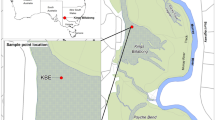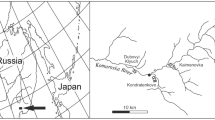Abstract
Analyses of stable isotope (δ13C and δ15N) and C:N ratios of food webs within a floodplain and a constricted-channel region of the Ohio River during October 1993 and July 1994 indicate that the increasingly influential flood pulse concept (FPC) does not, for either location, adequately address food web structure for this very large river. Furthermore, results of this study suggest that the riverine productivity model (RPM) is more appropriate than the widely known river continuum concept (RCC) for the constricted region of this river. These␣conclusions are based on stable isotope analyses of potential sources of organic matter (riparian C3 trees, riparian C4 grasses and agricultural crops, submerged macrophytes, benthic filamentous algae, benthic particulate organic matter, and transported organic matter containing detritus and phytoplankton) and various functional feeding groups of invertebrate and fish consumers. The FPC, which stresses the key contribution of organic matter, particularly terrestrial organic matter, originating from the floodplain to riverine food webs, was judged inappropriate for the floodplain region of the Ohio River for hydrodynamic and biotic reasons. The rising limb and peak period of discharge typically occur in November through March when temperatures are low (generally much less than 10°C) and greater than bank-full conditions are relatively unpredictable and short-lived. The major food potentially available to riverine organisms migrating into the floodplain would be decaying vegetation because autotrophic production is temperature and light limited and terrestrial insect production is minimal at that time. It is clear from our data that terrestrial C4 plants contribute little, if anything, to the consumer food web (based on δ13C values), and δ15N values for C3 plants, coarse benthic organic matter, and fine benthic organic matter were too depleted (∼7–12‰ lower than most invertebrate consumer values) for this organic matter to be supporting the food web. The RPM, which emphasizes the primary role of autotrophic production in large rivers, is the most viable of the remaining two ecosystem models for the constricted-channel region of the Ohio based on stable isotope linkage between sources and consumers of organic matter in the food web. The most important form of food web organic matter is apparently transported (suspended) fine (FTOM) and ultra-fine particulate organic matter. We propose that phytoplankton and detritus of an autochthonous origin in the seston would represent a more usable energy source for benthic (bivalve molluscs, hydropsychid caddisflies) and planktonic (microcrustaceans) suspension feeders than the more refractory allochthonous materials derived from upstream processing of terrestrial organic matter. Benthic grazers depend heavily on nonfilamentous benthic algae (based on gut analysis from a separate study), but filamentous benthic algae have no apparent connection to invertebrate consumers (based on δ13C values). Amphipod and crayfish show a strong relationship to aquatic macrophytes (possibly through detrital organic matter rather than living plant tissue). These observations contrast with the prediction of the RCC that food webs in large rivers are based principally on refractory FTOM and dissolved organic matter from upstream inefficiencies in organic-matter processing and the bacteria growing upon these suspended or dissolved detrital compounds. The conclusions drawn here for the Ohio River cannot yet be extended to other floodplain and constricted-channel rivers in temperate and tropical latitudes until more comparable data are available on relatively pristine and moderately regulated rivers.
Similar content being viewed by others
Author information
Authors and Affiliations
Additional information
Received: 3 January 1997 / Accepted: 28 August 1998
Rights and permissions
About this article
Cite this article
Thorp, J., Delong, M., Greenwood, K. et al. Isotopic analysis of three food web theories in constricted and floodplain regions of a large river. Oecologia 117, 551–563 (1998). https://doi.org/10.1007/s004420050692
Issue Date:
DOI: https://doi.org/10.1007/s004420050692




